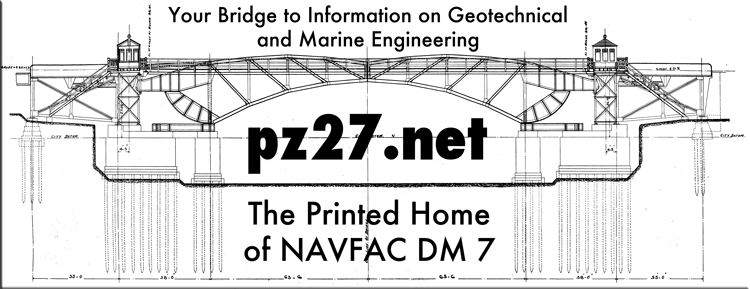It’s been a favourite topic of this site to consider the issue of alpha vs. beta methods for deep foundations (both driven and bored piles.) In our post Shaft Friction for Driven Piles in Clay: Alpha or Beta Methods? we show that the Kolk and van der Velde method for driven piles in clay can be converted from an alpha method to a beta one by some simple math. The key to this success is that the ratio of undrained shear strength to effective stress is at the core of the method.
If we want to simplify things further, we can consider this, from the “new” NAVFAC DM 7.1, originally from Skemption:
(1)
where
undrained shear strength of the soil
= vertical effective stress of the soil
plasticity index of the soil

The relationship between undrained shear strength and vertical effective stress in a qualitative sense is illustrated by the diagram at the right, from Broms.
Substituting this into our derived value for in the Kolk and van der Velde method yields
(2)
where
ratio of the vertical stress to the horizontal friction on the pile shaft
length of the pile
distance from the soil surface
diameter of the pile
This makes the factor simply a function of the pile geometry and the plasticity index at a depth
.
But can this be done for methods where the relationship between undrained shear strength and the effective stress? The answer is “sort of,” and this post will explore that possibility.
Let us consider an example from the Dennis and Olson method for driven piles. It is a classic “alpha-beta” type of formulation; we will only consider the alpha method portion of the method. For a beta method to be equivalent to an alpha method, the following must hold:
(3)
We should note that, for the beta side of the method,
(4)
where
geometry factor based on the aspect ratio of the pile
lateral earth pressure coefficient
friction angle of the pile-soil interface
We will not consider this computation further, but only assume that
(5)
For the shaft resistance in clay
(6)
The two F constants are defined in the original monograph. The relationship between and
is shown below.
This is more complicated than, say the O’Neill and Reese method for drilled shafts. But the idea is the same. Our goal is basically to convert the values of alpha (where c is an independent variable) to use as a beta method.
We start by modifying Equation (3) for the Dennis and Olson method thus:
(7)
Solving for ,
(8)
Substituting Equation (1) into Equation (8) yields
(9)
The remaining difficulty is that is a function of
. This can be dealt with by manipulating Equation (1) to read
(10)
in which case
(11)
The left hand side is the independent variable of the graph above; the right hand side can be computed to substitute for that same independent variable.
Let us consider an example, namely the one used in the Dennis and Olson example:
The problem here is that we are given an undrained shear strength value for the clay layer but not a plasticity index. We are given a unit weight for the clay layer (not automatic for problems like this.) So we can compute the ratio of the undrained shear strength to the effective stress. For the top layer, the midpoint effective stress is 900 psf, and the undrained shear strength 2000 psf. The ratio is thus 2000/900 = 2.22. From Equation (1), the plasticity index is about 571. This, of course, is highly unlikely, and illustrates an important point about academically formulated problems: they’re not always realistic in their parameters. For the effective stress levels we have, it is likely that the undrained shear strength needs to be considerably lower than is given in the problem.
In any case substituting and
from the original data and
from the current data yields
, which is the same as the original. From here we can compute
and, substituting into Equation (9), we obtain
. Multiplying this by the effective stress of 900 psi yields the same result of
.
Conclusion
- Getting rid of
altogether is hampered by the fact that there is not an analytic function for
in the first place. The Dennis and Olson method is not unique in this regard.
- For methods such as Kolk and van der Velde where the ratio of undrained shear stress and vertical effective stress are important parts of the method, applying correlations such as Equation (1) is fairly simple. When this is not the case then things are more complicated.
- Using Equation (1) is doubtless a good check on values of
, which when applied in an alpha method implicitly contains the effects of effective stress.
- Going forward, probably the best way to “close the loop” and make all methods beta methods is to formulate the method for clays in terms of
as is the case with Kolk and van der Velde. Doing this would be an important step in moving static methods forward.



One thought on “Can Any Alpha Method be Converted to a Beta Method?”